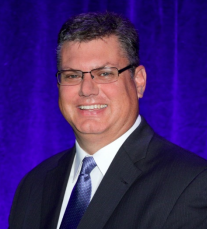Listen now as Patrick Horine explains how he brought much-needed change and innovation to hospital accreditation!
At SAMC we have spent a considerable amount of time working in healthcare organizations and with healthcare clients. When I spoke recently at the 2018 Society for Healthcare Strategy and Marketing Development (SHSMD) conference, I was approached by a woman who wanted to tell me about an inspirational leader, Patrick Horine, President of DNV GL Healthcare. I followed up with Patrick and was in awe of what he and his company are doing—namely, changing the way we are going to be evaluating and accrediting healthcare institutions in the future. Isn’t that a huge “Blue Ocean Strategy”?
Bring Blue Ocean Strategy to healthcare big time
 Patrick is trying to open a new market space by adding value innovatively, creating something new—not just disrupting what is in place today, but seeing it with fresh eyes. The problem with healthcare isn’t what it was. Neither is the solution what we thought we could do in the past.
Patrick is trying to open a new market space by adding value innovatively, creating something new—not just disrupting what is in place today, but seeing it with fresh eyes. The problem with healthcare isn’t what it was. Neither is the solution what we thought we could do in the past.
DNV GL Healthcare is the second-largest hospital accrediting body in the United States, certifying more than 500 hospitals in 49 states that participate in the Medicare program. It is also the fastest-growing accrediting body in the industry.
Based on his experiences as a hospital administrator, Patrick saw that the process by which hospitals were accredited was seriously flawed. essentially, it failed to provide a framework for hospitals to actually improve the quality and safety of the care they provided. His innovative idea of a totally new approach to accreditation is especially important today, when regulatory bodies and media are questioning the validity of the decades-old approach to compliance.
Here are some of the questions and Patrick’s answers that are the core of our conversation:
1. Patrick, why are you so passionate about the accreditation process, and what is the approach to accreditation that DNV GL uses?
- The earlier part of my career found myself working in hospitals. I was a student at Purdue University, did not spend enough time studying, and was asked to leave. I wound up taking a job at a local hospital and discovered immediately this was what I wanted to do. I finished up college in less than four years, got a master’s degree and would up as a hospital CEO at the age of 29. The work I did in that role with accrediting bodies drove me to want to improve the process. I saw too many surveys that focused on “gotchas” for minor offenses, as opposed to improving the overall quality of the operations—and therefore the patient outcomes. I wanted to re-imagine the process of accreditation as a collaborative effort rather than an adversarial one. I formed what is now known as DNV GL Healthcare with my mother-in-law, starting in the basement of my home. It required years of persistence, but it is now paying off.
- DNV GL uses ISO 9001 quality control protocols, a quality approach that is used across the world. DNV GL adapted ISO from the manufacturing sector and applied it to hospitals, within the framework that hospitals are required to follow in order to participate in the Medicare program.
2. The spotlight has been placed on accrediting bodies as of late. What issues are you trying to address by revamping the accreditation process?
- Questions have arisen about the old model of accreditation. That’s why I wanted to ensure that accreditation did not merely consist of hospitals trying to pass their onsite surveys to get the surveyors out of the hospital for the next three years…which I can tell you, was often the attitude surrounding those accreditation visits. Instead, I wanted to change the mindset of hospital executives and their staff so they were driven to improve their overall operations and constantly think about how they can make the delivery of healthcare services better.
- DNV GL’s surveys occur every year as opposed to every three years, which keeps hospitals on their toes. They are also encouraged to self-audit on an ongoing basis to determine how best they can improve their processes.
- I also wanted to ensure that the hospital and accreditation staff were in a collaborative relationship rather than an adversarial one. By positively engaging with the hospitals, we become partners in their ongoing quest for improvement.
3. Which clients are benefiting from the change? These are very relevant case studies on how the changes can become part of the “way we do things” and not something you avoid doing.
- Overall, our hospitals are seeing improvement in lower readmission and higher patient satisfaction ratings. Let me give you some examples of how hospitals are improving their services:
- Sentara Halifax Regional Hospital in Virginia found that they were essentially ordering restraints for every patient in the ICU. Their people took a step back and worked on how they could improve their policies. Using ISO 9001 as a basis, they introduced very specific criteria as to when restraints should be used. As a result, they all but eliminated the use of restraints at the hospital. Despite this dialing back, the number of patients who extubated themselves—pulled out critical tubes that endanger their lives if they don’t remain inserted—also dropped dramatically.
- Charleston Area Medical Center in West Virginia was able to greatly improve its treatment for strokes. That’s a particularly daunting concern in West Virginia, where the rate of strokes is nearly 40% higher than the national average. It more than quadrupled the number of patients who received clot-busting drugs for ischemic strokes in a timely fashion, and also opened up a telestroke program to ensure patients receive care immediately even if there is not a neurologist in the hospital. As a result, it has received multiple awards from the American Stroke Association.
- CoxHealth, a hospital system in Missouri, started a program focused on reducing patient re-admissions. It embedded a social worker in its emergency rooms and trained local paramedics to conduct home visits of recently discharged patients to help address their medical, behavioral and social needs. Some of the hospitals saw a nearly 20% drop in their readmission rates as a result.
4. Why is it that hospitals and healthcare systems have some issues making these kinds of changes, even though care may wind up improving in the end? As you know, change—particularly corporate culture change—is an area where we focus a lot of our work.
- Naturally, there is always some resistance in large healthcare institutions where major change is afoot. However, many of our client hospitals have decided to change accrediting bodies because they were tired of doing it the traditional way. They wanted change; they had heard that DNV GL is a change agent, and that is why they made the switch.
- Our client hospitals do sometimes have issues regarding making major changes to make them better providers. However, they also have to become ISO 9001-certified within three years of DNV GL providing its first accreditation. That helps to institute a mindset where they are more willing to embrace change.
- Many of our client hospitals may initially think it can be more challenging working with DNV GL than other accrediting organizations because of the push for continuous improvement, but they are almost always pleased with the results.
5. What do you see in the future for hospital accreditation and hospital operations?
- Hospitals will be under increasing pressure to demonstrate that they are improving outcomes and patient safety. They will also be facing new operations challenges like precision medicine and the use of artificial intelligence in delivering and monitoring care. Now more than ever, they need a system that enables them to quickly identify and remedy problems, and to put in place processes that solve problems, permanently. We are there to help them find these solutions.
If you would like to connect with DNV GL and Patrick Horine, as well as his exceptional staff of talented individuals, you can reach them at: patrick.horine@dnvgl.com or 866-523-6842.
If your organization wants to make a change toward continuous quality improvement in collaboration with their accrediting body, or just wants some information about our company, please reach out.
Some background on Patrick
Patrick Horine serves as the President and Chief Executive Officer of DNV GL Healthcare and is responsible for the North American healthcare business of DNV GL, which includes a growing portfolio of standards-driven accreditation and certification services.
Patrick was part of an entrepreneurial team that created and brought to market the first new hospital accreditation program in the United States since the 1960s when Medicare was started. This program, the DNV GL National Integrated Accreditation of Healthcare Organizations (NIAHO®), has attracted more than 400 hospitals, and is recognized for its unique design, which integrates Medicare compliance with the ISO 9001 Quality Management System.
Patrick has more than 25 years of healthcare management experience and has held various leadership positions in hospitals including Chief Executive Officer, Chief Operating Officer and Vice President for Quality and Business Development. He has a Master’s Degree in Hospital and Health Administration from Xavier University.
To know more about this area, here’s a great start:
- An On The Brink podcast you will love: Rick Harris—Shouldn’t You Want to Delight Patients and Deliver Care?
- Case study: Charleston Area Medical Center: Improving Stroke Care
- Case study: CoxHealth: Improving Patient Readmissions
- Case study: Sentara Halifax Regional Hospital: Reducing Use Of Patient Restraints
Additional resources:
- My book: “On the Brink: A Fresh Lens to Take Your Business to New Heights“
- Our website: Simon Associates Management Consultants
Download the 1-page synopsis of my book, “On the Brink: A Fresh Lens to Take Your Business to New Heights” here




